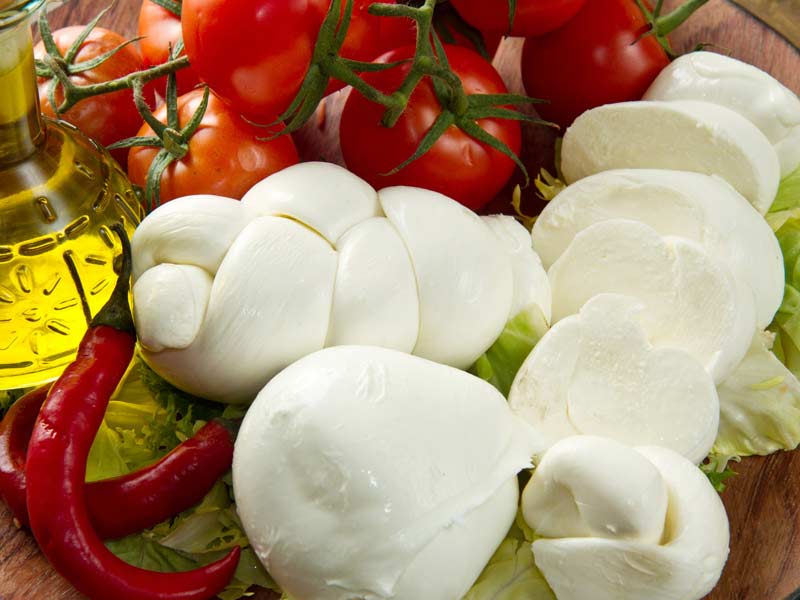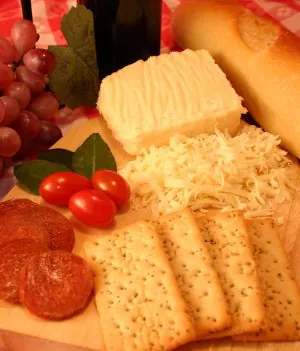Blog
Mozzarella: The Papa Of Fresh Cheese!

Mozzarella is a very famous fresh cheese, made from goat’s milk, cow’s milk or in some cases, buffalo’s milk by means of an intricate and complex process by the name of “pasta filata method”. Originally from southern Italy, its name is quiet common for many different types of Italian cheeses made using “spinning” and then “cutting” this original pasta coming from milk : The Italian verb “mozzare” means exactly “to cut”.
Some common and famous types are:
- Buffalo mozzarella made from domesticated buffalo milk;
- Mozzarella fior di latte (or simply Fiordilatte) is made from fresh pasteurized, or also unpasteurized, cow’s milk:
- Low-moisture mozzarella, which is made from whole or part skimmed milk, and widely used in the food-service industry;
- Smoked mozzarella (affumicata) called in this way for the treatment that is receives which gives it a very particular and special smell and taste;
Fresh mozzarella is usually white in its common visual expression, but this colour can vary seasonally to a very mild yellow depending on the specific diet with which the animal is fed. It is a semi-soft cheese and traditionally served the day after the production, but can be kept “in brine” for a week or even more if sold in vacuum-sealed packages. Low-moisture mozzarella can also be kept refrigerated for up to a month. It is also used for many types of pizza and many very famous and tasty pasta dishes (Cooking Mozzarella) but it can be also served with slices of tomatoes and basil in the very typical “insalata caprese”.
History
A bufala is a female water buffalo. Hers is the milk – rare and expensive – from which mozzarella is traditionally made. These days, however, you’re more likely to find a version made from cows’ milk, which is more readily available and much less costly.
The history of mozzarella is closely linked to that of the water buffalo. How and when did the animals arrive in Italy? Some say it was Hannibal, others talk about Arab invasions and still others say that India was the source. What we do know is that they began to be raised in the 12th century, at a time when many peasants, fleeing war and invasions, abandoned their land. That land turned marshy, which is exactly what water buffalo like. Several centuries later, northern Italy became concerned about cleaning up the marshlands, and in 1930, the south began a massive agrarian reform. The herds of water buffalo, the “black mine” that produced “white gold,” dwindled. Cow’s milk began to replace bufala milk in the recipe. Then, in 1940 the Nazis destroyed the remaining herds. After the war, water buffalo imported from India were reintroduced to Italy, but the cheese introduced to North America by Italian immigrants in New York at the turn of the 20th century and in Canada around 1949 was made with cow’s milk.
Aside from the milk, mozzarella’s other distinguishing feature is its stringy texture. After the whey is discarded, the curds are “strung” or “spun” to achieve the characteristic pasta filata. The cheese is then cut (in Italian, mozzare means to cut), immersed in water to firm it up, then covered in a light brine, in which it is kept until it is eaten.
Etymology of the name
The name was mentioned in a cookbook witten by Bartolomeo Scappi in the 1570: “milk cream, fresh butter, ricotta cheese, fresh mozzarella and milk” (…).
The name comes from the Neapolitan dialect (from Naples, the capital of Campania) and it is the diminutive of “mozza” which, as we saw, means “cut” or, if you want from the verb “mozzare” (to cut) and it rappresents the technique of working the pasta coming from milk.
A very similar cheese is “Scamorza” which probably derives from scamozzata which leterally means “without a shirt”, reffered to the appearance of these cheeses “without” hard surface covering typical of many other dry cheeses.
Types
“Mozzarella di bufala campana” as mentioned before is a specific quality made from the buffalo’s milk: these are raised in specific areas of the territory of the regions of Lazio and Campania (Italy).
Unlike other types, that can derive from non-Italian milk and often semi-coagulated milk, the buffalo mozzarella holds the status of “Denominazione di Origine Protetta” (protected designation of origin – PDO 1996) under the European Union, While in 1996 mozzarella was recognized as a Specialità Tradizionale Garantita (STG) which translated means “Traditional Speciality Guaranteed”.
Fior di latte or simply Fiordilatte is a mozzarella made only from cow’s milk (not from buffalo). The quality of this product is inferior compared to the one from buffalo and as consequence also the price of this type of mozzarella is lower. It is for this reason that is always important the certification of the label because, especially abroad it is not unusual to find “mozzarella” not clearly labeled as deriving from buffalo made instead from cow’s milk.
Composition
You can find two type of Mozzarella: fresh or partly dried.
- The fresh one is usually shaped into balls that weigh 80-100 grams, for a diameter that usually is not more than 5- 6 centimetres. Specific brands can nevertheless make balls that can reach 1 kilogram for or about 10-12 centimetres in diameter. This fresh version is usually soaked in salt water (brine) or whey, rarely with the addition of citric acid;
- The partly dried mozzarella is more compact and dense, usually used to prepare dishes cooked in the oven, such as “pasta al forno”, pizza, etc.
It is possible to twist the “pasta filante” with the result that the final shape is a plait: this type of mozzarella is called “Treccia”. and it can have many length according to the final destination: Sunday 13 of June 2006 after 6 hours of work, Avellino won the Guinness World Record with the longest Mozzarella Treccia in the world – 106,16 meters. But usually the dimension is from few centimeters to few decimeters.
An other interesting and very typical type is the so called “Mozzarella affumicata” which is a is smoked varietes, very tasty and with a light brown collor due to the smoke that is on the surfice of the cheese.
“Nodini” is an other type of mozzarella: the term means little knots and in fact he shapes is made by weaving once the “pasta filante” and the dimension is typically around 3-4 cm. Similar to bocconcini, but a unique knot shape, this cheese gives a nicer texture and ability to expose more surface with about the same volume.
“Mozzarella Sfoglia” , literally “mozzarella sheet” is a cheese inspired by traditional puff pastry; especially in Puglia, it is the traditional base for the preparation of sweet and savoury recipes, stuffed to create original hot and cold dishes.
Several variants of mozzarella are specifically formulated for pizza: “Cooking Mozzarella” is a low-moisture Mozzarella cheese: as you can understand it contains less water than real one”.
Mozzarella can be shaped in very particular ways and artistic shapes such as elephant, pig, dummy, which are widely produced in Southern Italy: the aim of this idea is to distract where possible kids from eating junk food/candies and so for snacks and focusing on high calcium and healthy cheese instead but keeping the fun and interest high.
“Burrata” meaning “buttered”: it is a dreamy fresh cheese that consists of a Mozzarella pouch, rather than a ball, filled with a delicate milky-mousse. When you bite into it, the fillinggently oozes out. Delicious!
Stop into Shisler’s Cheese House and pick up some of your own Mozzarella!







